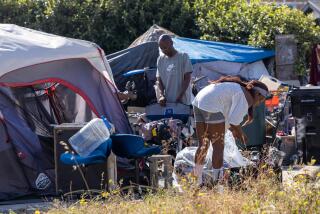L.A. County’s homeless population is growing — but not as fast as they’re dying
- Share via
A record number of homeless people are dying across Los Angeles County — on bus benches, hillsides, railroad tracks and sidewalks.
Last year alone, 918 people died. And in the last five years, deaths have jumped 76%, outpacing the growth of the homeless population, according to an analysis of county coroner data by Kaiser Health News.
So far, health officials and experts have been unable to pinpoint a single cause for the increase, but say rising substance abuse may be a major reason.
The surge also reflects a rise in the number of people who are chronically homeless and who don’t typically use shelters, meaning more people are living longer on the streets with serious physical and behavioral health issues, they say.
“It is a combination of people who are living for a long time in unhealthy situations and who have multiple health problems,” said Michael Cousineau, a professor at the Keck School of Medicine of USC. “There are more complications, and one of those complications is a high mortality rate. It’s just a tragedy.”
Nearly 53,000 people were homeless in L.A. County last year and most were not living in shelters, according to a point-in-time count of homeless residents. That’s an increase of about 39% since 2014.
The homeless population also has grown nationwide, but there is no national count of homeless people who have died.
The Los Angeles County Department of Medical Examiner-Coroner considers someone homeless if that person doesn’t have an established residence, or if the person’s body was found in an encampment, shelter or other location that suggests homelessness.
Based on those criteria, the coroner reported there were 3,612 homeless people who died in L.A. County between 2014 and 2018.
A detailed look at the data reveals a complex picture of where — and how — homeless people are dying. One-third died in hospitals. Even more died outside, in alleyways, parking lots, riverbeds and on freeway on-ramps.
The deaths of homeless men outnumbered the deaths of homeless women, but the percentage of women who died increased faster than for men. And although African Americans make up less than one-tenth of the county’s population, they accounted for nearly a quarter of the homeless deaths.
“We need to take action now,” said the Rev. Andy Bales, CEO of the Union Rescue Mission, a homeless shelter on L.A.’s skid row. “Otherwise next year it’s going to be more than 1,000.”
Drugs and alcohol played a direct role in at least a quarter of the deaths of homeless people over the past five years, according to the analysis from the county coroner’s office. The substances also likely contributed to many more deaths, including those whose deaths were related to liver and heart problems.
The coroner’s cause-of-death determination “doesn’t necessarily tell the whole story,” said Brian Elias, the county’s chief of coroner investigations, who called the increase “alarming.”
A person who is homeless might get an infection on top of a chronic disease on top of a substance abuse disorder — and all of those together lead to a bad outcome. “It’s a house of cards,” said Coley King, a physician at the Venice Family Clinic.
Raymond Thill was just 46 when he died last year of what his wife, Sherry Thill, called complications related to alcoholism. The couple had been homeless for many years before moving into a small apartment in South Los Angeles shortly before his death.
Thill said her husband often drank vodka throughout the day, and had been in and out of the hospital because of liver and other health problems. He tried rehab and she tried taking the alcohol away from him. Nothing worked.
“His mind was set,” she said. “So I took care of him.”
In the end, Thill said, cirrhosis left her husband jaundiced, swollen and unable to keep food down.
King treated Raymond Thill before his death and is convinced that Thill would have lived longer if he’d gotten off the streets sooner.
“This shouldn’t be happening,” especially when many deaths could have been prevented with better access to healthcare and housing, said David Snow, a sociology professor at UC Irvine. “If you are on the streets, you are not getting the attention you need.”
Based on the data analysis, homeless people in Los Angeles County died from many of the same ailments as the general population — heart disease, cancer, lung disease, diabetes and infections. But they did so at a much younger age, said Dr. Paul Gregerson, who treats homeless residents as chief medical officer for JWCH Institute clinics in the Los Angeles area.
A stressful lifestyle, lack of healthy food and constant exposure to the weather all contribute to an early death, he said. The average age at which homeless people died in Los Angeles County was 48 for women and 51 for men.
Overall in California, the life expectancy was 83 for women in California and 79 for men in 2016 — among the best in the nation for longevity.
“If you are homeless, your body ages faster from living outside,” Gregerson said.
Also over the five-year period in L.A. County, according to the analysis, there was a spike in deaths of younger adults who were homeless. The deaths of adults under 45 more than doubled, for instance.
The data do not include information about whether they had mental illnesses, which Elias of the coroner’s office said could be a contributing factor in some of the deaths.
Stephen Rosenstein, 59, was walking across the street in the L.A. neighborhood of Panorama City one night last year, when a car struck and killed him, said his sister, Cindy Garcia. He had spent years bouncing back and forth from the streets to shelters to board-and-care homes. Rosenstein had been diagnosed with schizophrenia and manic depression, Garcia said, and often resisted help — behavior she attributed to his mental illness.
“Most people would want to have a roof over your head,” she said. “He just fought it all the way.”
Rosenstein’s cause of death was listed as “traumatic injuries.” Deaths by trauma or violence were common among the homeless identified in the coroner’s data: At least 800 people died from trauma, and of those, about 200 were shot or stabbed.
“They are ready for bad luck to happen,” King said.
Anna Gorman and Harriet Blair Rowan report for Kaiser Health News, a national health policy news service and editorially independent program of the Kaiser Family Foundation. [email protected]
More to Read
Sign up for Essential California
The most important California stories and recommendations in your inbox every morning.
You may occasionally receive promotional content from the Los Angeles Times.










